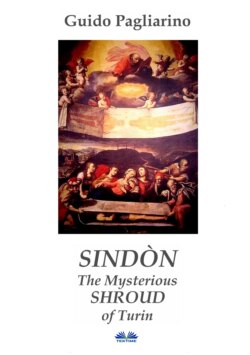Читать книгу Sindòn The Mysterious Shroud Of Turin - Guido Pagliarino - Страница 7
ОглавлениеA) General introduction :
The Shroud – Holy Shroud for Catholics – is a linen cloth (sindòn = shroud, cloth) just 0.34 mm thick; the relic's weave pattern is a "herringbone", with a technique used two thousand years ago in Egypt (there are even five-thousand-year-old Egyptian artifacts) , in Palestine and in other Middle Est areas; the yarn is described as a "Z-twist" (clockwise twisting), unlike the "S-twist" process (counter-clockwise twisting) used in later times7 . They are spinning and weaving techniques no longer considered since the early Middle Ages. The Cloth is 4.41 meters long and 1.13 wide, after the 2002 conservative restoration (see Chronology, , 2002 AD)8 . The Archbishop pro tempore of Turin (namely, in office at the time) is its Custodian. The Shroud is housed in Turin since 1578, with some temporary displacements due to wars: such as when the French besieged the city in 1706, or when the Shroud was transferred to the Montevergine Abbey (near Avellino, Italy) to protect it from the bombings when Italy entered the World War II in 1939. It returned to Turin in 1946.
The Shroud of Turin, simply known as “The Shroud” all over the world, is still a mysterious cloth for the most part.
Several stains, whose origin and interpretation is only partially known, can be found on the Shroud, which is like a photographic negative for some of them and not for others.
No doubt . ..
Patches and burn marks are clearly detectable on this sheet.
After sampling and analysis by experts, microscopic pollen of plants from Middle East and Alps were found on the Shroud. Furthermore, evidence of aloe and myrrh was identified, along with aragonite (a composition of calcium carbonate, iron and strontium); the latter is a mineral present in Jerusalem, and in particular inside a tomb examined by the University of Chicago researcher Riccardo Levy-Setti who claimed that the two soil, respectively coming from the Shroud and from the Jerusalem grave, were exactly the same type.
Definitely there are AB type clotted bloodstains with trace of human male DNA on the linen cloth, according to studies by several internationally renowned pathologists, such as Pier Luigi Baima Bollone (professor emeritus of Forensic Medicine at the University of Turin).
By the way: It is curious that the same AB group blood was detected on the Sudarium of Oviedo (Spain), a 83x52 cm cloth. These are mirror-like bloodstains and, according to many, they overall would look like a human face 9 . Furthermore, it is interesting that the remains (relics) of the miracle which, according to tradition, occurred in the city of Lanciano, Italy, in the 8th century (a monk had doubted the presence of Christ in the Eucharist when, during a Mass celebration, bread and wine suddenly turned into flesh and blood) are: AB group clotted blood, the same as the Shroud; human flesh from myocardial tissue (as emerged from the analysis by the pathologist Professor Odoardo Linoli in 1970).10
Below, pictures depicting the Sudarium of Oviedo
and
the Ostensory at the Sanctuary of Lanciano with the flesh and a crystal cup containing the clotted blood :
